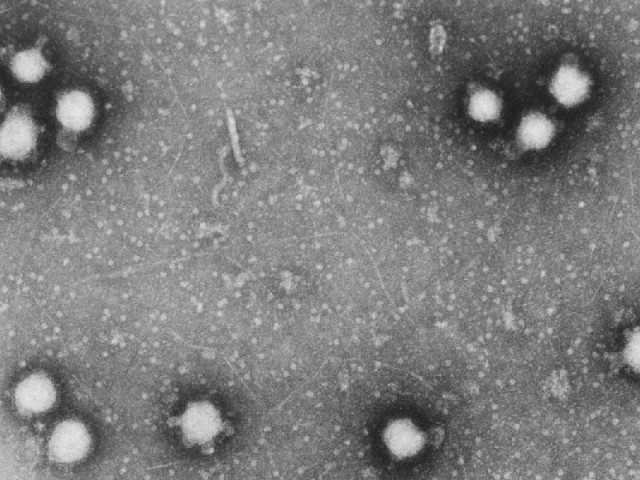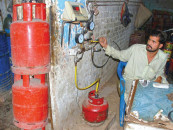Expert urges people to keep calm, take precautions against 3 misunderstood diseases
Cases of Congo fever, dengue and PAM earlier this year created panic.

Sometimes man’s best friend can be host to one of his worst enemies - ticks carrying the lethal Crimean-Congo haemorrhagic fever. If you have a furry friend in your home, it might be prudent to ensure that the unwanted guests aren’t around.
Dr Afia Zafar, the chairperson of Aga Khan University Hospital’s infection control committee, delivered a presentation on Thursday at the institution’s sports and recreation centre. Her aim was to banish misconceptions about three diseases whose presence in Karachi has alarmed many - Crimean-Congo haemorrhagic fever, dengue and primary amoebic meningoencephalitis (PAM).
The timing of the event couldn’t have been better. The very same day, nine more cases of dengue were confirmed at Civil hospital, bringing the total figure for the disease in Sindh up to 203. The Congo fever has claimed at least three lives in the city and ten cases have been reported since January. Rounding up the deadly trio is naeglaria fowleri, a parasite which claimed the lives of at least nine people in Karachi this year.
But Dr Zafar told a small group of journalists that these statistics shouldn’t paralyse people with fear. Though the diseases are potentially fatal, simple precautionary measures can be highly effective against them. She shared information about the signs and symptoms of the diseases as well as the primary modes of transmission, with the hope that this would allay any panic.
Congo fever
The viral disease spreads through contact with an infected person’s blood and tissue. Ticks are also notorious for biting the hand that feeds them - figuratively and literally. A bite by these tiny insects might also lead to Congo fever.
Typically, the symptoms begin to appear between three and nine days after the insect bites. On the onset of the disease, a person may develop flu-like symptoms, including fever, aching muscles, stiffness, headaches, sore eyes and photophobia.
Around three to five days after the onset, patients might show signs of hemorrhage - nosebleeds as well as coughing blood or having traces of it in urine and feces. In around 30 per cent of the cases, the patient dies. The vast majority who do pull through begin to feel better around the ninth or tenth day after the virus’ onset.
As always, prevention is better than cure. People who work with livestock or have pets should use repellant lotions and should use gloves to check the animals for ticks. Healthcare workers are also at risk. People who have been exposed to an infected person’s blood should monitor their temperature daily and watch out for symptoms for at least 14 days.
Dengue
Thanks to the awareness campaigns following previous epidemics of the disease, ‘aedes aegypti’, the mosquito which is a vector of the disease, has become a household name and many can now easily identify its distinct black and white markings. There are four strains of the disease and infection by one type does not necessarily grant immunity against other types - in fact, a second infection can be even more dangerous.
A severe form of the disease is characterised by high fever, severe abdominal pain, enlarged liver and circulatory failure. A person may go into shock between two and seven days after the fever develops. There is no specific anti-viral drug to treat dengue. Patients should be kept well hydrated and be confined to bed rest. In severe cases, intravenous drips and blood transfusion might be required.
Infection can be prevented by using mosquito repellants and take extra precaution at dawn and dusk, the two times of the day that the insect feeds. Full-sleeve clothes should be worn to minimise exposure to the disease and all stagnant water in the house should be drained.
Primary amoebic meningoencephalitis
Naegleria fowleri is yet another household name and achieved that status following the five cases of the disease in July. The amoeba is commonly found in freshwater lakes and infects people when contaminated water enters their noses.
This usually occurs when people go swimming or diving in freshwater. The parasite travels up the nasal cavity and into the brain, where it then proceeds to destroy tissue. Naegleria fowleri is a heat-loving microbe.
Initial symptoms start about five days after the parasite enters the body. They include headache, fever, nausea and vomiting. Later, the patient may experience a stiff neck as well as seizures and be confused or start hallucinating. The disease progresses rapidly and usually kills people within five days of the onset of symptoms. The fatality rate is over 99 per cent.
People should seek medical care immediately whenever they develop fever suddenly along with a headache, stiff neck and vomiting.
The best way to avoid the disease is to avoid dipping into pools of water that are not chlorinated.
Published in The Express Tribune, September 22nd, 2012.



















COMMENTS
Comments are moderated and generally will be posted if they are on-topic and not abusive.
For more information, please see our Comments FAQ